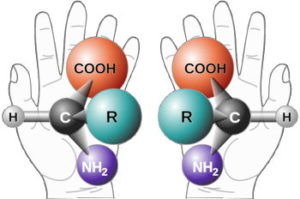Most people don’t know it, but there is a big difference between Natural and Synthetic Vitamins. These differences are noted in Chemistry by their basic molecular structure, which is determined by whether the Vitamin comes from a naturally occurring source or a manufactured synthetic source. It is very important that we understand this and are aware of the effects Synthetic Vitamins have on our bodies versus the Natural Vitamins.
I am going to explain how this works by breaking down the Chemistry with simple examples on a very common Vitamin we all need.
Vitamin E
First off, let me define “molecule”.
Molecule (mol·e·cule) – Noun : 1. smallest part of chemical compound: the smallest physical unit of a substance that can exist independently, consisting of one or more atoms held together by chemical forces. – Encarta Dictionary
Most molecules in living organisms (humans, animals, and plants) have mirror images of themselves called “enantiomers.” An example of this would be that one’s left and right hands are “the same” but opposite mirror images of each other. We identify these mirror images of molecules by the directions they turn or rotate as either D- (right-hand) spin or L- (left-hand) spin.
The “L-“ stands for levorotary, which means “left-hand“. The “D-“ stands for dextrorotary, which means “right-hand“. When L or D are applied to a chemical compound, such as “tocopherol”, (the fat-soluble antioxidant Vitamin E) it means that the chemical compound tocopherol either turns or spins to the left or the right.
“D-tocopherol” means that the chemical compound tocopherol turns or spins to the right and usually means that the compound is naturally occurring. “L-tocopherol” means that the chemical compound tocopherol turns or spins to the left and usually means that the compound is synthetic.
D-tocopherol is a natural form of Vitamin E occurring from wheat bran, whereas L-tocopherol, or often seen as L-tocopherol acetate, is a synthetic form of Vitamin E, consisting of the backing of photographic camera film, which is broken down and turned into synthetic Vitamin E.
While the laws insist that synthetics and naturals are the same, I disagree! Vitamin E made from photographic camera film is just as good as Vitamin E made from wheat bran? Aren’t we warned NOT to eat camera film? We know that synthetic Vitamin B can be very toxic, causing infertility in pigs. We are warned not to take synthetic B in high doses. The same goes for synthetic Vitamin A. The ONLY synthetic vitamin that seems not to have too much of an adverse effect on humans is Vitamin C.
This chemistry applies to almost all chemical compounds, especially vitamins D-, d- or L-, l- are always found in front of the chemical names on the ingredient labels of vitamins. Most natural, healthy foods have a right-hand turn or spin in their molecular makeup and will be noted with a D- in front of their chemical names. Foods with synthetic compounds have a left-hand turn in their molecular makeup and will be noted with an L- in front of their chemical names.
An example of an L- type naturally occurring plant in nature is the Soy plant – one of the best plants to remove Arsenic and Fluoride from the soil. It takes out the toxic material from the soil and leaves nitrogen in. However, the soybean has 500% too much female estrogen. It is also is an L- type material. So, even 100% organically grown Soy is still L- form and has the same excess female estrogen problem. While Soy is good for cleaning up the soil do you think we have any business in eating soymilk, tofu, soy oil, or vitamins made from soy?
*As a side note, soy that is very heavily fermented by bacteria, such as Soy sauce, Miso, and Tempe are actually healthy to eat in moderate quantities.
So, the lesson is to stick to consuming Natural Vitamins and stay clear of the synthetics, it’s just better for the body and the Chemistry just adds up better.


